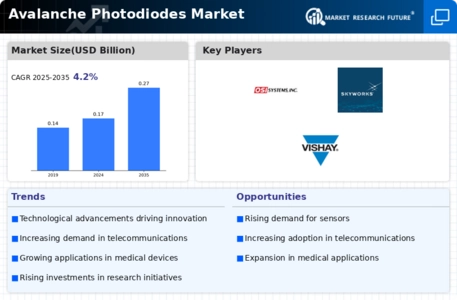Top Industry Leaders in the Avalanche Photodiodes Market

The Competitive Landscape of the Avalanche Photodiodes Market
Avalanche photodiodes (APDs), once confined to the realm of esoteric scientific instruments, have emerged from the shadows to illuminate a thriving market brimming with innovation. These sensitive photon detectors, amplifying faint light signals with unrivaled efficiency, are powering diverse applications from high-speed fiber optic networks to cutting-edge medical imaging equipment. Navigating this dynamic landscape requires a keen understanding of the competitive dynamics, adopted strategies, key players, and emerging trends shaping the future of APD technology.
Some of the Avalanche Photodiodes companies listed below:
- Lumentum Holdings Inc.
- Hamamatsu Photonics K.K.
- Renesas Electronics Corporation
- Excelitas Technologies Corp.
- First Sensor AG
- Global Communication Semiconductors, LLC
- KYOTO SEMICONDUCTOR Co., Ltd.
- Laser Components Germany GmbH
- Luna Innovations Incorporated
- OSI Systems, Inc.
Strategies Adopted by Leaders:
- Embracing Innovation and Cutting-Edge Technologies: Investing in R&D to integrate novel advancements like quantum dot technology for enhanced sensitivity, integrated microfluidic cooling for high-power applications, and advanced material engineering for improved operating wavelengths, can differentiate solutions and cater to evolving user needs.
- Prioritizing User Education and Technical Support: Providing comprehensive technical documentation, application notes, and robust technical support ensures users leverage the full potential of the APDs and fosters ongoing customer satisfaction.
- Partnerships and Ecosystem Building: Collaborating with equipment manufacturers, system integrators, and software developers expands reach, offers complete solutions, and strengthens brand presence.
- Focus on Miniaturization and Integration: Developing compact, low-power APDs suitable for portable instrumentation and resource-constrained environments opens up new application possibilities.
- Sustainability and Environmental Considerations: Utilizing materials with minimal environmental impact, employing energy-efficient manufacturing processes, and offering compliant packaging cater to customers with growing sustainability concerns.
Factors for Market Share Analysis:
- Product Portfolio and Technological Breadth: The range and sophistication of APDs offered, encompassing varying materials like silicon, indium gallium arsenide (InGaAs), and germanium, with diverse active area sizes, operating wavelengths, and gain levels, significantly impact market reach. Catering to specific applications, such as high-bandwidth telecoms or low-noise astronomical observations, can be significant differentiators.
- Target Market Focus: Focusing on specific segments within the technology ecosystem, such as telecommunications, aerospace and defense, healthcare, industrial sensing, or scientific research, requires tailored products and partnership strategies. Addressing the unique needs of each segment can solidify market share within that niche.
- Integration and Compatibility: Seamless integration with existing equipment and software platforms, including compatibility with diverse fiber optic connectors and data acquisition systems, expands potential customers and fosters broader market adoption.
- Brand Reputation and Trust: In a technically complex domain, a strong brand built on reliability, high-performance specifications, and a proven track record in APD technologies inspires confidence among demanding users. Established players like Renesas Electronics Corporation and Excelitas Technologies Corp. often have an edge in this regard.
- Pricing Strategy and Value Proposition: Striking the right balance between affordability and feature depth is essential. Offering flexible pricing models like tiered configurations, bulk discounts, or custom production for niche applications can broaden appeal and increase market penetration.
New and Emerging Companies:
- Niche-Focused Startups: Companies like Kyosemi Corporation and GPD Optoelectronics Corp. specialize in developing APDs for specific applications like high-speed laser ranging in autonomous vehicles or biophotonics research, offering tailored features and performance optimized for demanding environments.
- Software-Centric Platforms: Companies like Excelitas Technologies Corp. and Laser Components focus on developing software platforms that optimize APD performance, simplify data acquisition and analysis, and integrate seamlessly with existing laboratory infrastructures.
- Open-Source Hardware Advocates: Companies like Open Photonics Project promote open-source APD designs and readily available fabrication instructions, empowering researchers and DIY enthusiasts with customization options and fostering innovation within the community.
Latest Company Updates:
May 2023, CMC Electronics Inc. launched a series of 1064-nm silicon avalanche photodiode (APD) preamplifier modules designed to improve laser applications. They can be used to quickly, accurately, and consistently detect ultralow light signals at long distances. The receivers feature a high signal-to-noise ratio and provide accurate and consistent readings even in challenging conditions. Users benefit from fast overload recovery that minimizes receiver damage and usage interruption from high laser bursts.
May 2023, Researchers at the University of Sheffield announced the development of an avalanche photodiode (APD) with significant potential for low photon detection. This novel photodiode cuts excess noise and enhances detection efficiency. The researchers believe that the highly sensitive gallium arsenide antimonide/aluminum gallium arsenide antimonide (GaAsSb/AlGaAsSb) separate absorption and multiplication avalanche photodiode (SAM-APD) will enhance the development of IR APDs, demonstrates very little added noise to interfere with signal recognition.
Mar. 30, 2021, Advanced Photonix Inc. introduced compact and rugged large-area avalanche photodiodes (LAAPDs) for aerospace, defense, medical, and industrial applications. The electro-optical large avalanche photodiodes come in cooled or uncooled packages with low noise levels and high stable gain. The devices operate at power levels of 2000 volts with gains of up to 300 volts. The LAAPDs are available in 3, 5, 10, to 16 millimeters active area diameters.
May 2021, Excelitas Technologies launched two InGaAs avalanche photodiodes, C30645L-080 and C30662L-200, that are designed for high-volume eye-safe laser rangefinding and lidar time-of-flight systems. These InGaAs avalanche photodiodes are optimized for 1550 nm. Optimized for 1550 nm, they feature a 3 × 3 mm2 SMT ceramic package, a detection area of 80 µm and 200 µm, and a spectral response of 1000–1700 nm.








